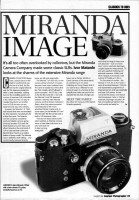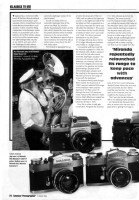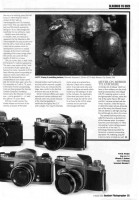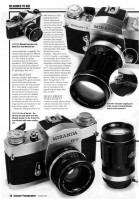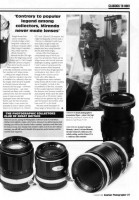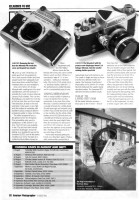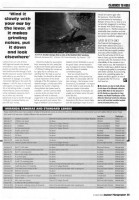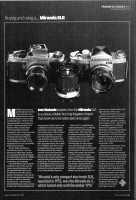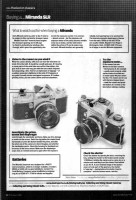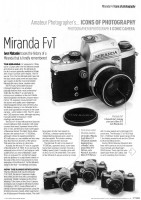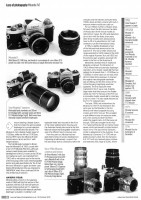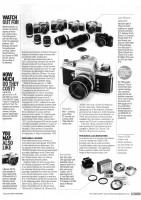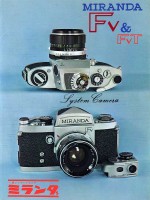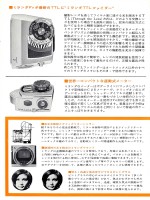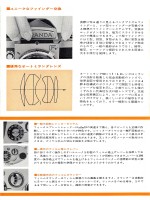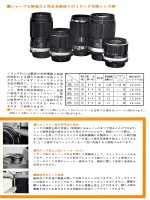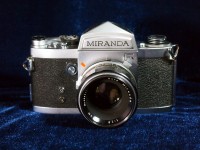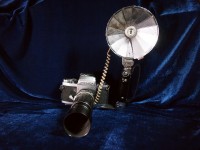Early period
The company’s founders were Ogihara Akira (萩原彰, 1920–1992) and Ōtsuka Shintarō (大塚新太郎, 1921-2005). Ogihara studied aeronautical engineering in the Imperial University of Tokyo (later University of Tokyo) during World War II, and worked on pulse jet engines for the Japanese Navy in the University’s aeronautical research center. He notably developed the pulse jet engine of a manned flying bomb inspired by the German V1, the Ka-10 (カ10) engine for the Baika (梅花). Ōtsuka graduated from the same department one year after Ogihara, and worked on the compressor of the Ne-20 (ネ20) engine for the Kikka (橘花) jet fighter.
When the war ended, all military research was halted in Japan, and Ogihara started a small camera workshop in a room of the former aeronautical research center. He was offering repairs and modifications for professional cameras, notably making Leica mount barrels for older lenses or military camera lenses. At the time, Ōtsuka was working on gas turbines for civilian applications; he soon became aware of Ogihara’s activities and partnered with him.
Ogihara founded the company during the period, under the name Orion Seiki Sangyō Y.K. (オリオン精機産業有限会社, meaning Orion Precision Products Industries Co., Ltd.), perhaps in 1947 — some sources say 1946, but this seems too early. The company was named after the constellation of Orion, because Ogihara had a special interest in astronomy. Its early logo consisted of the word ORION with three stars and an arc; the three stars correspond to Orion’s belt, and the arc is often associated with the figure of the mythological hunter Orion in drawing the constellation.
The company’s first product was the Coupler, an adapter designed by Ōtsuka to use Contax lenses or Nikon lenses on Leica screw mount cameras while keeping the rangefinder coupling. The next products, released in the early to mid 1950s, were the Mirax reflex housings, Supreme lenses and Focabell bellows. These were first distributed by Summit Shōkai, then by Matsushima, managed by Mikami Makoto (三神誠). In addition to these early products, it is said that Orion Seiki worked as a subcontractor for Yashima Kōgaku on the production of microscopes.
From Orion to Miranda
In 1954, the company presented the Phoenix 35mm SLR prototype to the Japanese photographic press. Ogihara and Ōtsuka had been developing an SLR camera for several years, and the Phoenix was mainly developed as a promotional product to advertise their future camera. Ogihara visited various distributors to obtain funds for the development of the production camera, but the only one who accepted was Mikami, who provided financial support. Orion Seiki was renamed Orion Camera K.K. (オリオンカメラ㈱) in 1955, with an equity base of 3 million yen (it seems that the name “Orion Camera Co.” was already in use for some time as an English translation of Orion Seiki). The production SLR was released that same year and named the Miranda T, the first Japanese 35mm SLR camera commercially available with a pentaprism.
The company finally named itself Miranda Camera K.K. (ミランダカメラ㈱) after its main product in 1957. On the Japanese market, the early Mirandas were still distributed by Matsushima for some time, then perhaps by the company itself. The distribution was briefly taken over by Ricoh from early 1959, as prominently announced in early advertisements for the Miranda B. It is said that this decision to join with Miranda was directly made by Ricoh’s founder Ichimura Kiyoshi (市村清). The agreement was however short-lived: the sales of Miranda cameras abruptly stopped in the domestic market in mid-1959 for an unknown reason, and for a few years Miranda cameras were made only for export. The US import was handled by Allied Impex (or AIC), owner of the Soligor brand, notably used on the lenses for the Miranda cameras.
In 1960, the company dropped the original dodecagonal body for a rounded body on the late-model Miranda D. It also released the Automex, with a built-in external selenium meter, and new lenses with internal diaphragm actuation and a cam transmitting the aperture setting to the body for meter coupling.
Into Allied Impex
It is said that the Miranda company set up its own lens factory in 1963 (earlier lenses were supplied by various manufacturers, except for the first Supreme). The company returned to the Japanese market in autumn 1964, but the US importer Allied Impex gradually took control, and fully owned the company by the late 1960s.
The Sensorex model was released in 1967, with TTL exposure metering. It is said that a new factory was opened outside Tokyo in 1970 or perhaps 1971. In 1971, the company introduced the Sensorex EE with shutter-priority automatic exposure and a new set of viewfinders. Upgraded as the EE-2 in 1976, it would be the last Miranda with interchangeable viewfinder.
In 1972, the company released its only non-SLR camera, the Sensoret compact rangefinder. In 1975, it made an attempt at a compact SLR with fixed prism and electronically controlled shutter, called the Miranda dx-3. Neither of these met with great success, and the Miranda company went bankrupt on December 10, 1976 and stopped camera production the same month.
Sources:
– Camerapedia: ‘Miranda‘
– Wikipedia: ‘Miranda Camera Company‘
– ‘Miranda Camera‘ homepage
– Amateur Photographer articles
Amateur Photographer, August 2000
Amateur Photographer, October 2008
Amateur Photographer, October 2013
I’m going to deal here only with the main subject of this site, the model Fv and its immediate predecessors. For additional information about the other Miranda camera models please see either the ‘Links‘-section below, or the ‘Museum‘ page.
Miranda Fv / FvT
The original japanese Fv / FvT sales brochure:
The Miranda Fv was introduced in 1966 (or 1967, depending on sources). Its lineage started life as a model F in 1962, which was a notable update to the previous models; it had a non-rotating shutter dial and an internal diaphragm control, but retained the front shutter release and the interchangeable viewfinder system of the older models. The 1964 FM model got a CdS meter built into the prism housing, while the 1965 model G got an awkward-looking external plug-in meter, but also a lockable oversize mirror, which feature combined with a magnifying viewfinder made it popular to astronomers for telescope use. The 1967 model GT finally got a proper prism with built-in TTL (‘Through The Lens’) CdS meter.
The Fv is a simplified version of G, without the lockable mirror; the 1968 FvT is just a Fv fitted with a TTL meter from GT model as standard.
Some technical data of Fv:
– Introduced: 1966
– Shutter: Mechanically-controlled, horizontal-travel focal plane. Speeds B, and 1 to 1/1000.
– Lens: Auto Miranda 50mm f/1.9 as standard
– Interchangeable viewfinder: Optional Waist-level finder VF-1, and two types of critical finders, VF-3 and VF-4. Because the viewfinder mount was similar, viewfinders from other models could also be fitted.
My Miranda Fv (bought as new by my father in 1967 or so) in all its glory:
– on the left, a standard configuration with standard viewfinder prism and an Auto Miranda 50mm f/1.9 lens.
– on the right with an FvT / GT TTL exposure meter prism, Soligor 2x teleconverter, Auto Miranda 135mm f/3.5 lens and Accura Bouncemaster folding fan flash + Accura Mark II flash handle.
Miranda camera information
Miranda Society Japan
Miranda instruction manuals

